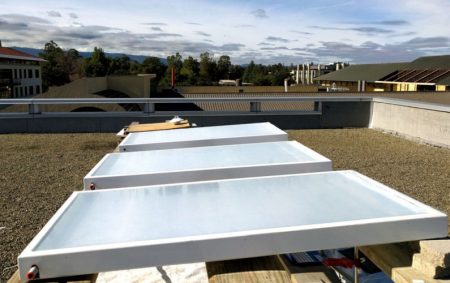September 5, 2017 – One way our species can reduce the impact of greenhouse gas emissions is through energy conservation. The energy needed to keep buildings cool in the summer is seen as a growing challenge globally not just because mean temperatures have been rising, but also because Developing World countries have been aspiring to install air conditioning infrastructure in increasing volume. The contribution today of air conditioning amounts to 10% of all greenhouse gas emissions globally and 15% of electricity demand. That’s why I keep looking for the newest inventions that can give us better solutions to cooling without cranking up the air conditioning.
In a journal article appearing in Nature Energy yesterday, I was quite excited to read about a new solar water cooler created by a trio of Stanford researchers: Eli Goldstein, Aaswath Raman, and Shanhui Fan. The device, based on their initial tests, lowers air conditioning electrical demand by as much as 21%.
In the Nature Energy article, entitled, “Sub-ambient non-evaporative fluid cooling with the sky,” they describe the global dilemma we face with cooling demand expanded to increase 10-times between now and 2050 as temperatures climb and Developing World countries install air conditioning.
How are these new water cooling panels constructed and how do they work? Seen in the picture below they consist of three components:
- a layer of thin-film silver-coated plastic.
- copper tubing lying circulating water at a rate of 0.2 liters per minute.
- a sealed housing for thermal insulation.
The thin-film plastic reflects 97% of sunlight by converting the energy to infrared which then gets reflected back into space. This creates a radiative sky cooling effect which lowers the temperature of the air inside the sealed housing which in turn lowers the temperature of the water circulating in the copper tubes contained within it.
The researchers tested three of their panels on the rooftop of a building on the Stanford campus, and the paper published yesterday describes their results. The water temperature in the copper tubing dropped by 5 Celsius (9 Fahrenheit) degrees over three days. The radiative cooling worked.
Interestingly, the thin-film plastic material used by the Stanford team is similar to a technology I recently described invented by engineers at the University of Colorado in Boulder.
Applying the data from the three-panel experiment the Stanford team ran a computer simulation using a two-storey office building in Las Vegas as an ideal model. They wanted to calculate the potential savings their radiative sky cooling could produce and Vegas was the best place to consider since its climate is both hot and dry. The simulation showed very promising results. Over several summer months, the building would have saved 14.3 megawatt-hours of electricity with the range of savings varying monthly between 18 and 50%. Average energy reduction over the entire simulation totaled 21%.
Not surprising, the researchers have created SkyCool Systems, a new venture that aims to commercialize the technology and are conducting a first large field trial on building rooftops in Davis, California.









